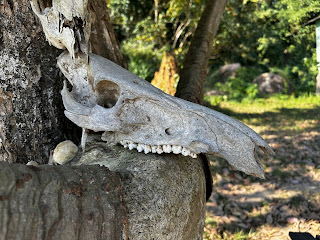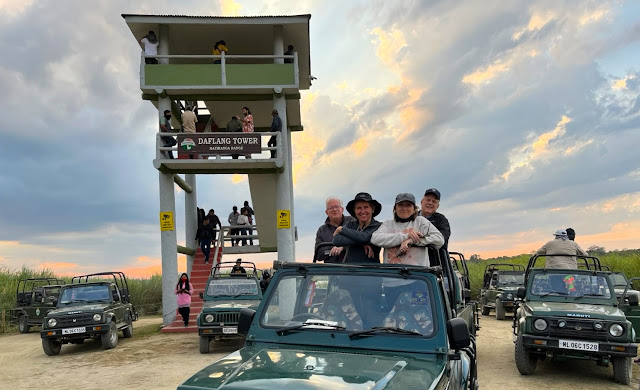December 18, 2024
We got off early in the morning and were welcomed to the Jeep by hot water bottles for our laps/feet and a nice warm blanket. There were also hot water bottles in our beds at night. Luxurious.
We didn't get very far before Bob saw a bird, or our guide saw a bird, and we had to stop for a look-see.
After driving on the main road for a while, we pulled off into the the Burhapahar Range, located in the western part of the park and known for its hilly terrain and dense forests.
There were a few jungle fowl showing off their fancy feathers in the yard . . .
I got the sense that there were animals all around, but they didn't want to come out to play.
 |
| Giant black squirrels |
 |
| Capped langur monkeys |
 |
| More monkeys |
There is quite a bit of water in Kaziranga National Park, and where there is water, there are ducks. Our guide had a bird book that he used to give us the names of the fowl we saw. Bob didn't seem to need it, but I sure did.
I liked this part of Kaziranga--green and peaceful.
Whoa, check out the twining vines! It looks like something from a Disney movie.
In addition to being an excellent spotter, our guide, Bablu Hussain, was great at making sure we got out of the Jeep every now and then to stretch our legs and soothe our bottoms.
Nope, those aren't tigers, Bob, just feral cats.
Asian woolly-necked storks:
Well, good-bye to the dirt roads for a bit while we go back to camp . . .
. . . for some lunch:
No time for a nap. It's back on the road for another Tiger Hunt.
Hey, look, tigers! Mother Nature set the table for you for lunch!
This drive was through the Central Range of the park. How can you not love these trees?
I mean REALLY. Doesn't that look like a scene that should have a tiger walking through it?
Bablu told us that this area often floods during the rainy season. The lookout tower shows the height of some of the more significant floods in recent years.
We crossed this rickety wooden trestle bridge about four times during the afternoon. Each time we began to cross, I held my breath and didn't exhale until we got to the other side. (That's supposed to keep you safe, you know.)
We never got very close to a herd of elephants, but we did see quite a few. This herd has a lot of little ones!
Oh wait! We didn't stop for the scenery! We stopped because Bablu's eagle eyes spotted a hoopoe (a crested bird), which apparently I couldn't see even with my phone's telelphoto camera lens!
Bablu spotted something walking down the middle of the road. Could it be a tiger? Only if it is wearing body armor. This is one roadblock you don't want to try to ram through.
Here's another "look closer" shot. See the pretty scenery on the left? Did you see the crane in the tree? Me neither.
We joined a dozen or so jeep-loads of Tiger Spotters at an observation tower but decided not to climb all those stairs unless it became apparent that someone was seeing some(tiger)thing.
Nope. Just two hog deer. But look at that sunset! It's tiger-colored!
I think this is the elephant herd we saw earlier near the entrance to the park. They are working elephants, used for tourist rides and other activities.
This grouping of three rhinos (an adult male and female and a calf) and three forest guards stands at this entrance to the national park. The three rhinos were made of ash from the burning of 2,479 rhino horns collected from seized poached horns over a period of 40 years. The display honors the efforts of those who work to protect the one-horned rhino. Apparently poaching has dropped significantly in the last few years because of their efforts.
We made our way through the loud, crowded, colorful night market of Kohor, the small town bordering this entrance to the park . . .








































































I loved Kaziranga. I particularly loved the rhinos. They were so much more accessible and interactive than the ones in Africa. They seem to be kind of moody, yet would come near the vehicle. And they look like they are covered with metal armor.
ReplyDelete